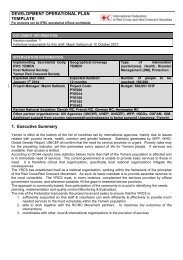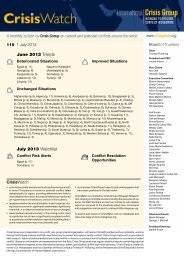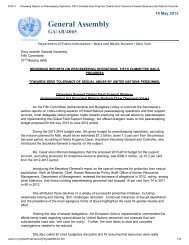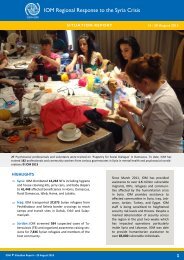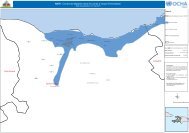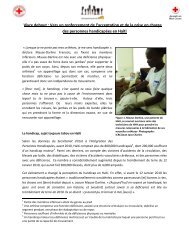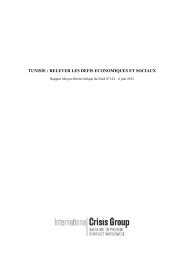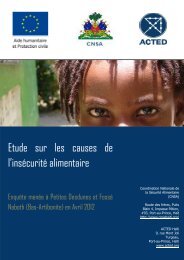SOMALI NUTRITION STRATEGY 2011 – 2013 - ReliefWeb
SOMALI NUTRITION STRATEGY 2011 – 2013 - ReliefWeb
SOMALI NUTRITION STRATEGY 2011 – 2013 - ReliefWeb
Create successful ePaper yourself
Turn your PDF publications into a flip-book with our unique Google optimized e-Paper software.
4<br />
IMPLEMENTATION<br />
13<br />
The logical framework defining goal, outcomes, outputs and activities and associated indicators<br />
for monitoring progress is included in annex 1. In addition, a results-based matrix detailing the<br />
activities, responsible agencies and time frame for action will be developed. Due to constraints<br />
to rapid scale up of interventions (restrictions in access, logistic, human and financial resources)<br />
a phased approach to implementation is proposed. Activities for the first year (phase 1) will be<br />
focused on the adaption and standardisation of tools, training and strengthening of structures and<br />
mechanisms in preparation for delivery of interventions in Phase 2. In this way, achievements<br />
of the first year will build the foundation for subsequent years. In view of the different context<br />
and challenges of the three zones, implementation of proposed activities will also be phased by<br />
geographical location, depending on access, capacity and resources available.<br />
4.1 Opportunities<br />
Restricted access, poor infrastructure and<br />
limited means in the face of huge needs<br />
means innovative ways of intervening<br />
in Somalia are called for. Opportunities<br />
arise from existing structures, pilots and<br />
programmes which provide entry points for<br />
strengthening, scaling up and delivering<br />
complementary essential activities. These<br />
opportunity areas are summarised below<br />
with more detail found in Table 2 of the<br />
situational analysis.<br />
• The strength and funding of existing<br />
nutrition programmes which provide<br />
existing structures through which to<br />
OTP nurse explaining healthy messages to OTP<br />
attendants, Baadbuke OTP site Save the Children<br />
deliver essential complementary services (deworming, immunisation, promotion of good<br />
hygiene) thereby maximising the potential benefit of nutritional input<br />
• Existing and upcoming interventions and programmes through which quality nutrition activities<br />
can be delivered • Accelerated Young Child Survival (AYCS) initiative Child Health Days,<br />
GAVI Health System Strengthening (HSS) funded Female Community-based Health Workers<br />
& Behaviour Change Communication (BCC) strategy<br />
• Pilot of new interventions with possibilities for scale up <strong>–</strong> FAO Trials of Improved Practices,<br />
Plumpy doz for prevention of moderate malnutrition<br />
• Globally accepted guidelines and proven effective interventions that can be adapted to the<br />
Somali context<br />
• WHO community based initiatives (CBI) like Basic Development Needs (BDN) and Healthy<br />
City Initiatives <strong>–</strong> community structures already in place as the basis for community based<br />
interventions.<br />
• Mosques and schools provide existing community structures for innovative delivery of<br />
population based interventions such as deworming, micronutrient supplementation and<br />
nutrition education.




